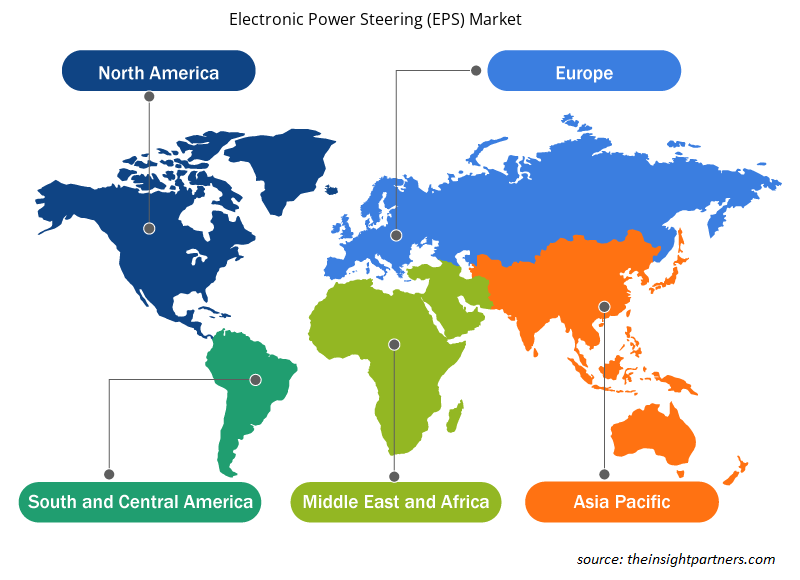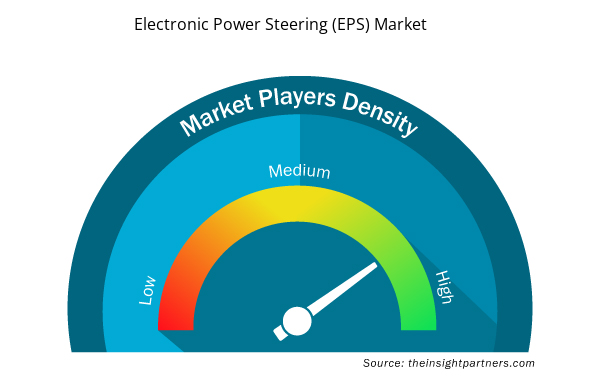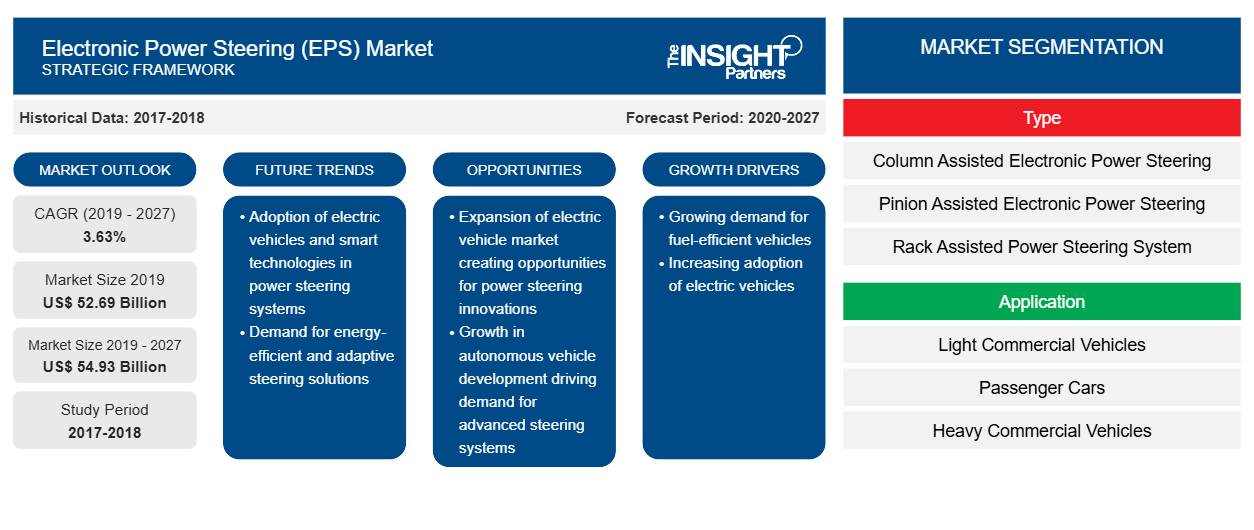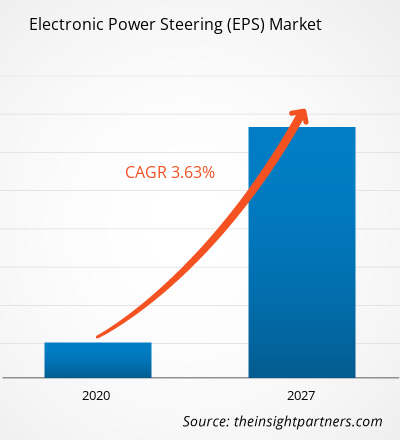El mercado mundial de dirección asistida electrónica se valoró en US$ 52.692,31 millones en 2019 y se espera que crezca a una CAGR del 3,63% durante el período de pronóstico de 2020 a 2027.
El mercado de la dirección asistida electrónica está ampliamente segmentado en cinco regiones principales: América del Norte, Europa, APAC, MEA y SAM. El mercado global estuvo dominado por la región APAC en 2019, que representó casi la mitad del mercado total debido a una mayor demanda de sistemas de dirección asistida electrónica. Factores como la adopción más extensa de automóviles premium, sedanes y SUV entre la población de APAC contribuyen significativamente a la participación de mercado más significativa de la región. Además, Ford Motor Company of Australia Limited, Toyota Motor Corporation Australia Limited, Mitsubishi Motors Australia Ltd. (MMAL), General Motors Holden, Isuzu Australia Limited, Volkswagen Group Australia Pty Ltd. y Hyundai Commercial Vehicles Australia son algunos de los fabricantes de vehículos comerciales más conocidos en el país. Todos estos fabricantes exigen la integración de EPS en los automóviles para satisfacer la demanda emergente de los clientes. Además, se espera que las crecientes operaciones de fabricación de automóviles, la creciente demanda de vehículos eléctricos y el enfoque creciente de los fabricantes de EPS en ofrecer productos de bajo costo y alta eficiencia impulsen el crecimiento del mercado de EPS en el resto de los países de APAC durante el período de pronóstico.
Perspectivas de mercado: mercado de dirección asistida electrónica
Crecen las ventas de coches de gama alta en China
Personalice este informe según sus necesidades
Obtendrá personalización en cualquier informe, sin cargo, incluidas partes de este informe o análisis a nivel de país, paquete de datos de Excel, así como también grandes ofertas y descuentos para empresas emergentes y universidades.
- Obtenga las principales tendencias clave del mercado de este informe.Esta muestra GRATUITA incluirá análisis de datos, desde tendencias del mercado hasta estimaciones y pronósticos.
En 2019, China representó casi 21,4 millones de vehículos. El país es el mayor productor y el mayor mercado de ventas de automóviles a nivel mundial. Sin embargo, en 2019, las ventas totales de automóviles cayeron un ~1,9%, pero la demanda de SUV y sedanes de automóviles premium aumentó a una tasa del 3,5% y el 18,8% respectivamente en comparación con 2018. Todos los principales fabricantes de vehículos de lujo en el país, incluidos BMW, Mercedes-Benz y Audi, informaron cifras positivas en noviembre de 2019. Junto con el aumento de las ventas, el escenario del mercado también cambió rápidamente. En la generación anterior, los consumidores solían comprar vehículos premium principalmente para revelar su estatus social, pero la nueva generación de compradores progresivamente sofisticada está comprando automóviles premium por la necesidad de lujo y tecnologías inteligentes. Según un estudio realizado por la Asociación China de Fabricantes de Automóviles, las mujeres desempeñan un papel importante en el mercado chino de automóviles premium. Esta encuesta indicó que, al momento de elegir un modelo de vehículo, las mujeres valoran las características de seguridad, la comodidad y el estilo exterior por sobre las cualidades que prefieren sus contrapartes masculinas, como la tecnología del tren motriz, marcas premium reconocidas socialmente y modelos más grandes. Los factores mencionados anteriormente impulsarán la demanda de la integración de EPS en sedanes y SUV.
Impacto de COVID-19
La industria automotriz y de semiconductores es una de las víctimas de la COVID-19 y, desde principios de 2020, estas industrias han reflejado una tendencia a la baja. Con la imposición del confinamiento en países de América del Norte, Europa y Asia, las industrias han sido testigos de una experiencia devastadora. La industria automotriz requiere una cantidad significativa de mano de obra humana y, por el contrario, el virus COVID-19 se está propagando a través de la participación humana, por lo que el sector no puede funcionar correctamente. La tendencia a la baja en la industria automotriz y de semiconductores está reflejando un impacto negativo en el mercado de la dirección asistida electrónica.
Información sobre segmentos de tipo
Según el tipo, el segmento de dirección asistida electrónica asistida por columna dominó el mercado mundial de dirección asistida electrónica en 2019. El sistema de dirección asistida electrónica está reemplazando gradualmente al sistema de dirección convencional en los vehículos modernos. El principal beneficio de usar un sistema de dirección asistida electrónica es la capacidad de minimizar el consumo de energía. El sistema de dirección asistida electrónica asistida por columna (C-EPS) es uno de los tipos de sistema de dirección asistida electrónica.
Información sobre segmentos y tipos de vehículos
Según el tipo de vehículo, el segmento de automóviles de pasajeros tuvo la mayor participación en el mercado mundial de dirección asistida electrónica en 2019. Los automóviles de pasajeros son vehículos de transporte con no más de ocho asientos. Debido al empeoramiento del clima y la calidad del aire en países como Bangladesh, Pakistán, Mongolia, Afganistán e India, las personas están adoptando combustibles alternativos y tecnologías relacionadas en sus automóviles de pasajeros. Los automóviles de pasajeros se pueden dividir en sedán, hatchback y SUV o MUV. La demanda de vehículos de pasajeros está aumentando con el aumento del ingreso per cápita y la necesidad de lujo.
Los actores del mercado se centran en innovaciones y desarrollos de nuevos productos integrando tecnologías y características avanzadas en sus productos para competir con los competidores.
- En 2019, Nexteer Automotive anunció su hito de producción de 60 millones de sistemas de dirección asistida eléctrica (EPS) en todo el mundo. Estos sistemas podrían usarse en vehículos que van desde automóviles pequeños hasta camiones grandes. Los sistemas de dirección asistida eléctrica aumentan la eficiencia del combustible en un 6 % y las emisiones de CO2 en 8 gramos por km.
- En 2018, Robert Bosch GmbH instaló en todos los vehículos de la gama Maserati MY 2018 los sistemas de asistencia en carretera de Bosch para la función de conducción parcialmente automatizada. Junto con esta innovación, la dirección asistida eléctrica de Bosch (EPS), introducida en la gama Maserati MY2018, contribuye a la implementación de la tecnología de asistencia en carretera y otros sistemas avanzados de asistencia a la conducción.
- En 2018, Hyundai Mobis desarrolló un sistema de dirección asistida eléctrica que aprovecha dos circuitos electrónicos durante la conducción autónoma para mantener las capacidades de dirección normales en cualquier circunstancia.
Dirección asistida electrónica
Perspectivas regionales del mercado de dirección asistida electrónica (EPS)
Los analistas de Insight Partners explicaron en detalle las tendencias y los factores regionales que influyen en el mercado de dirección asistida electrónica (EPS) durante el período de pronóstico. Esta sección también analiza los segmentos y la geografía del mercado de dirección asistida electrónica (EPS) en América del Norte, Europa, Asia Pacífico, Oriente Medio y África, y América del Sur y Central.

- Obtenga datos regionales específicos para el mercado de dirección asistida electrónica (EPS)
Alcance del informe de mercado de dirección asistida electrónica (EPS)
| Atributo del informe | Detalles |
|---|---|
| Tamaño del mercado en 2019 | US$ 52,69 mil millones |
| Tamaño del mercado en 2027 | US$ 54,93 mil millones |
| CAGR global (2019-2027) | 3,63% |
| Datos históricos | 2017-2018 |
| Período de pronóstico | 2020-2027 |
| Segmentos cubiertos | Por tipo
|
| Regiones y países cubiertos | América del norte
|
| Líderes del mercado y perfiles de empresas clave |
|
Densidad de actores del mercado de dirección asistida electrónica (EPS): comprensión de su impacto en la dinámica empresarial
El mercado de la dirección asistida electrónica (EPS) está creciendo rápidamente, impulsado por la creciente demanda de los usuarios finales debido a factores como la evolución de las preferencias de los consumidores, los avances tecnológicos y una mayor conciencia de los beneficios del producto. A medida que aumenta la demanda, las empresas amplían sus ofertas, innovan para satisfacer las necesidades de los consumidores y aprovechan las tendencias emergentes, lo que impulsa aún más el crecimiento del mercado.
La densidad de actores del mercado se refiere a la distribución de las empresas o firmas que operan dentro de un mercado o industria en particular. Indica cuántos competidores (actores del mercado) están presentes en un espacio de mercado determinado en relación con su tamaño o valor total de mercado.
Las principales empresas que operan en el mercado de dirección asistida electrónica (EPS) son:
- Hyundai Mobis
- Corporación JTEKT
- Corporación Mitsubishi Electric
- Nexteer Automotriz
- Compañía NSK Ltd.
Descargo de responsabilidad : Las empresas enumeradas anteriormente no están clasificadas en ningún orden particular.

- Obtenga una descripción general de los principales actores clave del mercado de dirección asistida electrónica (EPS)
El mercado mundial de dirección asistida electrónica se ha segmentado de la siguiente manera:
Mercado de dirección asistida electrónica: por tipo
- Dirección asistida electrónicamente con asistencia por columna
- Dirección asistida electrónicamente con piñón
- Sistema de dirección asistida por cremallera
- Dirección asistida hidráulica electrónica
Mercado de dirección asistida electrónica: por tipo de vehículo
- Vehículos comerciales ligeros
- Automóviles de pasajeros
- Vehículos comerciales pesados
Mercado de dirección asistida electrónica por región
América del norte
- A NOSOTROS
- Canadá
- México
Europa
- Francia
- Alemania
- Italia
- Reino Unido
- Rusia
- Resto de Europa
Asia Pacífico (APAC)
- Porcelana
- India
- Corea del Sur
- Japón
- Australia
- Resto de APAC
Oriente Medio y África (MEA)
- Sudáfrica
- Arabia Saudita
- Emiratos Árabes Unidos
- Resto de MEA
América del Sur (SAM)
- Brasil
- Argentina
- Resto de SAM
Mercado de dirección asistida electrónica: perfiles de empresas
- Hyundai Mobis
- Corporación JTEKT
- Corporación Mitsubishi Electric
- Nexteer Automotriz
- Compañía NSK Ltd.
- Robert Bosch GmbH
- Corporación Showa
- La Corporación Mando
- ThyssenKrupp AG
- ZF Friedrichshafen AG
- Análisis histórico (2 años), año base, pronóstico (7 años) con CAGR
- Análisis PEST y FODA
- Tamaño del mercado Valor/volumen: global, regional, nacional
- Industria y panorama competitivo
- Conjunto de datos de Excel


- Pharmacovigilance and Drug Safety Software Market
- Aesthetic Medical Devices Market
- Employment Screening Services Market
- Saudi Arabia Drywall Panels Market
- Hand Sanitizer Market
- Biopharmaceutical Contract Manufacturing Market
- Green Hydrogen Market
- Vision Guided Robotics Software Market
- Electronic Health Record Market
- Explosion-Proof Equipment Market

Report Coverage
Revenue forecast, Company Analysis, Industry landscape, Growth factors, and Trends

Segment Covered
This text is related
to segments covered.

Regional Scope
North America, Europe, Asia Pacific, Middle East & Africa, South & Central America

Country Scope
This text is related
to country scope.
Preguntas frecuentes
The electronic power steering (EPS) market is led by passenger cars segment with highest share and is expected to dominate in the forecast period. Passenger cars are the transport vehicles with not more than eight seats. Due to the worsening weather and air quality in countries, such as Bangladesh, Pakistan, Mongolia, Afghanistan, India, people are adopting alternative fuel and related technologies in their passenger cars. Passenger cars can be divided into sedan, hatchback, and SUV or MUV. The demand for passenger vehicles is increasing with a rise in per capita income and need for luxury. The electronic power steering system is linked to the vehicle control unit.
There is an increase in adoption of buses and trucks, specifically for logistics and public transportation purposes, across the globe. In Asia, Oceania, and Europe, the public transportation is used more as compared to private transportation, whereas in North America, transportation is mainly through private vehicles. Growing population in urban areas is demanding the increasing public transportation with the improvement in existing transportation infrastructure is proving to be insufficient. The OEMs across the globe are now focusing on reducing the global carbon footprint, therefore, boosting the usage of electric vehicles is anticipated to offer ample growth opportunities for the global electronic power steering (EPS) market players.
Rising adoption of autonomous driving worldwide is one of the major factors boosting the adoption of steer-by-wire systems in the vehicles. SbW is enhancing the driving experience as well as safety. The SbW technology is currently experiencing a constant surge in development as well as demand. The higher levels of autonomous driving require uninterrupted communication, redundant power supply, and steering rack. Moreover, the SbW enhances the safety with the help of driver assistance systems. It also eliminates the intermediate steering shaft and thus, reduces the risk of injury to the driver from mechanical steering components by augmenting the passive safety in the vehicle.
Trends and growth analysis reports related to Automotive and Transportation : READ MORE..
The List of Companies - Electronic Power Steering Market
- Hyundai Mobis
- JTEKT Corporation
- Mitsubishi Electric Corporation
- Nexteer Automotive
- NSK Ltd.
- Robert Bosch GmbH
- Showa Corporation
- The Mando Corporation
- ThyssenKrupp AG
- ZF Friedrichshafen AG
The Insight Partners performs research in 4 major stages: Data Collection & Secondary Research, Primary Research, Data Analysis and Data Triangulation & Final Review.
- Data Collection and Secondary Research:
As a market research and consulting firm operating from a decade, we have published and advised several client across the globe. First step for any study will start with an assessment of currently available data and insights from existing reports. Further, historical and current market information is collected from Investor Presentations, Annual Reports, SEC Filings, etc., and other information related to company’s performance and market positioning are gathered from Paid Databases (Factiva, Hoovers, and Reuters) and various other publications available in public domain.
Several associations trade associates, technical forums, institutes, societies and organization are accessed to gain technical as well as market related insights through their publications such as research papers, blogs and press releases related to the studies are referred to get cues about the market. Further, white papers, journals, magazines, and other news articles published in last 3 years are scrutinized and analyzed to understand the current market trends.
- Primary Research:
The primarily interview analysis comprise of data obtained from industry participants interview and answers to survey questions gathered by in-house primary team.
For primary research, interviews are conducted with industry experts/CEOs/Marketing Managers/VPs/Subject Matter Experts from both demand and supply side to get a 360-degree view of the market. The primary team conducts several interviews based on the complexity of the markets to understand the various market trends and dynamics which makes research more credible and precise.
A typical research interview fulfils the following functions:
- Provides first-hand information on the market size, market trends, growth trends, competitive landscape, and outlook
- Validates and strengthens in-house secondary research findings
- Develops the analysis team’s expertise and market understanding
Primary research involves email interactions and telephone interviews for each market, category, segment, and sub-segment across geographies. The participants who typically take part in such a process include, but are not limited to:
- Industry participants: VPs, business development managers, market intelligence managers and national sales managers
- Outside experts: Valuation experts, research analysts and key opinion leaders specializing in the electronics and semiconductor industry.
Below is the breakup of our primary respondents by company, designation, and region:

Once we receive the confirmation from primary research sources or primary respondents, we finalize the base year market estimation and forecast the data as per the macroeconomic and microeconomic factors assessed during data collection.
- Data Analysis:
Once data is validated through both secondary as well as primary respondents, we finalize the market estimations by hypothesis formulation and factor analysis at regional and country level.
- Macro-Economic Factor Analysis:
We analyse macroeconomic indicators such the gross domestic product (GDP), increase in the demand for goods and services across industries, technological advancement, regional economic growth, governmental policies, the influence of COVID-19, PEST analysis, and other aspects. This analysis aids in setting benchmarks for various nations/regions and approximating market splits. Additionally, the general trend of the aforementioned components aid in determining the market's development possibilities.
- Country Level Data:
Various factors that are especially aligned to the country are taken into account to determine the market size for a certain area and country, including the presence of vendors, such as headquarters and offices, the country's GDP, demand patterns, and industry growth. To comprehend the market dynamics for the nation, a number of growth variables, inhibitors, application areas, and current market trends are researched. The aforementioned elements aid in determining the country's overall market's growth potential.
- Company Profile:
The “Table of Contents” is formulated by listing and analyzing more than 25 - 30 companies operating in the market ecosystem across geographies. However, we profile only 10 companies as a standard practice in our syndicate reports. These 10 companies comprise leading, emerging, and regional players. Nonetheless, our analysis is not restricted to the 10 listed companies, we also analyze other companies present in the market to develop a holistic view and understand the prevailing trends. The “Company Profiles” section in the report covers key facts, business description, products & services, financial information, SWOT analysis, and key developments. The financial information presented is extracted from the annual reports and official documents of the publicly listed companies. Upon collecting the information for the sections of respective companies, we verify them via various primary sources and then compile the data in respective company profiles. The company level information helps us in deriving the base number as well as in forecasting the market size.
- Developing Base Number:
Aggregation of sales statistics (2020-2022) and macro-economic factor, and other secondary and primary research insights are utilized to arrive at base number and related market shares for 2022. The data gaps are identified in this step and relevant market data is analyzed, collected from paid primary interviews or databases. On finalizing the base year market size, forecasts are developed on the basis of macro-economic, industry and market growth factors and company level analysis.
- Data Triangulation and Final Review:
The market findings and base year market size calculations are validated from supply as well as demand side. Demand side validations are based on macro-economic factor analysis and benchmarks for respective regions and countries. In case of supply side validations, revenues of major companies are estimated (in case not available) based on industry benchmark, approximate number of employees, product portfolio, and primary interviews revenues are gathered. Further revenue from target product/service segment is assessed to avoid overshooting of market statistics. In case of heavy deviations between supply and demand side values, all thes steps are repeated to achieve synchronization.
We follow an iterative model, wherein we share our research findings with Subject Matter Experts (SME’s) and Key Opinion Leaders (KOLs) until consensus view of the market is not formulated – this model negates any drastic deviation in the opinions of experts. Only validated and universally acceptable research findings are quoted in our reports.
We have important check points that we use to validate our research findings – which we call – data triangulation, where we validate the information, we generate from secondary sources with primary interviews and then we re-validate with our internal data bases and Subject matter experts. This comprehensive model enables us to deliver high quality, reliable data in shortest possible time.


 Obtenga una muestra gratuita de este informe
Obtenga una muestra gratuita de este informe